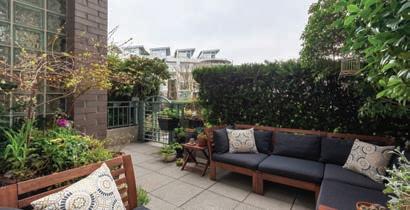
5 minute read
REAL ESTATE
REAL ESTATE Life leases create affordable sense of community
by Carlito Pablo
Advertisement
People often think about housing in terms of either homeownership or rental. ere’s another type, a cross between—or a hybrid of—the two general categories. It’s called a life lease.
Kate Mancer is a leading expert in Canada about this housing model, which ticks so many boxes that one might say it’s magical.
And as the Vancouver-based advocate explains, this is precisely the reason why she titled her 2019 book e Magic of Life Lease: A Seniors Housing Solution for the 21st Century.
“It really is a magical solution in so many ways,” Mancer told the Straight in a phone interview.
Mancer is talking not only about seniors housing but also life lease’s ability to enable new and a ordable housing for a wider population. e model works well with seniors because, typically, they own homes. When they sell, they can use the equity to acquire a life lease.
To explain, a life lease is an agreement wherein a person purchases the right to live in a home for as long as the individual wants. e buyer pays a lump sum upfront. A monthly fee covers maintenance charges.
When the person leaves or dies, the purchaser or their estate gets the money back. And depending on the terms, they may also get a portion of the property’s appreciation.
From beginning to end, the ownership of the home stays with the developer, which is called a “sponsor”.
Now, why would someone want to live in a life lease?
For one, Mancer said that this housing form provides a high quality of life for residents.
“ ey create a very strong sense of community and a very satisfying environment for people living in them,” Mancer said.
A ordability is another reason.
“Appraisers will o en say that if you don’t have title, that means the value of your unit is lowered by about 10 percent compared to a similar unit that you had a strata title to it,” Mancer explained.
Sponsors of life-lease projects are o en nonpro ts, so the prices of the units generally re ect the cost of development.
“ ey are being built on a nonpro t basis, so the typical developer pro t of 15 or 20 percent is not a part of the life-lease equation,” Mancer noted.
Another reason why life leases are desirable is that they lead to a better use of the housing stock. Mancer explained that by encouraging “overhoused” seniors to downsize, homes more suited to growing families become available.
She cited as example the Cedar Valley Manor, a 42-unit life-lease development in Mission.
“ e households who moved in that building were all living in single-detached houses, so they freed up 42 housing units for larger households, for families with kids,” Mancer said.
Another reason why Mancer believes that life leases should be encouraged is that they can enable the development of housing projects that otherwise would not be possible.
To illustrate, Mancer cited the case of the Performing Arts Lodge (PAL) in Vancouver. e housing development dedicated to performing artists is comprised of 99 socialhousing units, 12 life-lease units, and a theatre with space for rehearsals. PAL Vancouver opened in May 2006 at 581 Cardero Street in the city’s Coal Harbour neighbourhood. e nonpro t PAL Vancouver raised commitments of $3,144,000 for the lifelease units, thereby convincing the City of Vancouver, which owns the land, of its ability to become a sponsor. e city provided a $1-million grant.
Mancer is the principal of Lumina Services, a consulting company that focuses on seniors housing and health developments, and she is currently working with the Baptist Housing Society, a nonpro t that bought the Inglewood Care Centre in West Vancouver in 2020.
Inglewood provides 230 long-term-care beds, and these will be replaced as part of the facility’s phased redevelopment. When completed, the project will provide homes for 600 seniors and sta . e project will also include 125 life-lease suites. e Baptist Housing Society says online that it will “leverage proceeds of initial life lease sales to cover the cost of construction”. is will “also enhance the a ordability of other portions of the project where a private owner might otherwise harvest pro ts”.
“By generating revenue for the society, it will help them nance the development of the other components on the site,” Mancer said about how landowning nonpro ts, in general, bene t from life leases.
Another plus for life leases is that the nonpro t gets to accumulate funds when someone moves out. is happens when the value of the property’s appreciation is shared between the sponsor and the outgoing resident. “When they have enough, they buy back one of the life-lease units, which they then rent out to lower-income households,” Mancer said.
Life leases started in Manitoba and Saskatchewan during the 1980s. Mancer said that there are more than 300 life leases in Canada; of these, 20 are in B.C.
In 2017, Aspen Green opened at 3365 East 4th Avenue in Vancouver’s Hastings-Sunrise. Based on Mancer’s listing, it’s the second and only life-lease development to follow PAL Vancouver in the city. g
The Aspen Green life-lease development in the Hastings-Sunrise neighbourhood is one of only two such projects in Vancouver, with the other being Coal Harbour’s Performing Arts Lodge.
TH122 1288 MARINASIDE I $1,598,000
Just greenspace & a stream between your patio & the seawall Meticulously maintained 3 bed, 2 bath 1,365 SF townhouse Landscaped entry patio right o the sidewalk Completely renovated by the current owner w/ open floor plan living, dining & kitchen. Upstairs two of the bedrooms have doors to their own balcony Nice cross breeze with doors front & back on both levels. 2 parking stalls, pets and rentals allowed. A quiet oasis in the City. Showings by Appointment with a little notice. Rick 604 725 6200

STONEHOUSE
TEAM REAL ESTATE ADVISORS
604 255 7575
EMAILUS@STONEHOUSETEAM.COM






